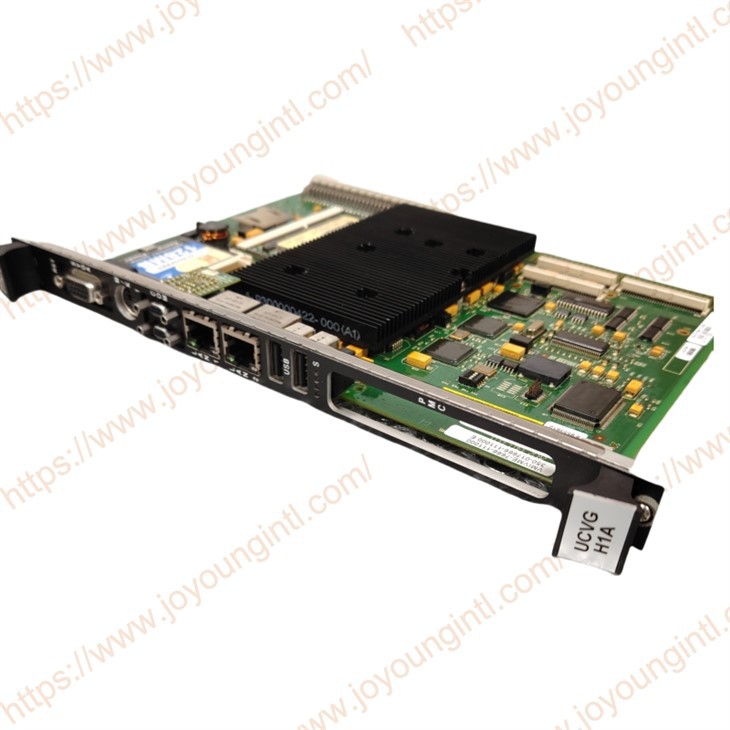Description
Technical Parameters
Product Introduction
The IS215UCVGH1A is a single-slot VME controller board from GE, part of the Mark VI Turbine Control System, used for managing gas and steam turbines. It features an Intel Ultra Low Voltage Celeron processor running at 650 MHz, 128 MB of SDRAM, and is designed for use in the Mark VI system, communicating with I/O boards via the VME bus. It runs the QNX operating system.

Technical Specifications
|
Manufacture |
General Electric(GE) |
|
Model |
IS215UCVGH1A |
| Part Number | IS215UCVGH1A |
|
Description |
Mark UCVG Controller
|
|
Origin |
USA |
|
Dimension |
30*20*6cm |
|
Weight |
0.35kg |
Product Details
The IS215UCVGH1A is a board assembly with a panel created for the GE Mark VI system, providing reliable and accurate voltage monitoring and control to ensure efficient operation and safety in industrial environments, commonly used in control systems and automation processes in industries such as manufacturing, energy, and transportation.
The IS215UCVGH1A is a single-slot version of the GE Mark VI UCV controller and is a direct replacement for previous controllers. Replacing this board does not require a backplane upgrade.
GE's UCV controller is a core component developed by General Electric (GE) for its Mark VI series gas/steam turbine management system. Its full name is Universal Control Valve Controller.
1. Hardware Architecture
Processor: It uses an Intel ultra-low voltage Celeron processor, such as IS215UCVGH1A, which uses an Intel ultra-low voltage Celeron 650 processor chip, with 128MB of SDRAM and 128MB of flash memory, which provides the necessary computing power and data storage capacity for the controller.
Interface: It is equipped with a variety of interfaces, including Ethernet port, serial port (COM port), USB connector, keyboard/mouse port, and SVGA monitor port, etc., which can easily communicate and connect with other devices to realize data transmission, equipment control, and human-computer interaction.
Status indicator: It usually has multiple LED indicators, such as B (start), I (IDE activity), P (power), R (circuit board reset), etc., which are used to display the working status of the controller, help users quickly understand the operation of the system, and facilitate troubleshooting and maintenance.
2. Software system: Generally runs a real-time operating system, such as the QNX operating system, which is a real-time, multi-tasking operating system that ensures that the controller can quickly, accurately and reliably handle various tasks in an industrial environment, meeting the strict requirements of gas/steam turbine control systems for real-time and stability.
3. Functional characteristics
Precise control: Mainly used to accurately adjust and control general control valves, manage fluid flow in turbine systems, and ensure efficient and stable operation of turbines.
VME bus communication: Designed to run in a VME bus environment, it communicates seamlessly with other input/output boards in the Mark VI system through the VME bus to achieve collaborative work between system components.
Industrial-grade reliability: It uses industrial-grade components and can adapt to harsh industrial environments such as high temperature, high humidity, vibration, and electromagnetic interference. It has high stability and reliability, can operate stably for a long time, and reduces maintenance costs and downtime.
Processor: It uses an Intel ultra-low voltage Celeron processor, such as IS215UCVGH1A, which uses an Intel ultra-low voltage Celeron 650 processor chip, with 128MB of SDRAM and 128MB of flash memory, which provides the necessary computing power and data storage capacity for the controller.
Interface: It is equipped with a variety of interfaces, including Ethernet port, serial port (COM port), USB connector, keyboard/mouse port, and SVGA monitor port, etc., which can easily communicate and connect with other devices to realize data transmission, equipment control, and human-computer interaction.
Status indicator: It usually has multiple LED indicators, such as B (start), I (IDE activity), P (power), R (circuit board reset), etc., which are used to display the working status of the controller, help users quickly understand the operation of the system, and facilitate troubleshooting and maintenance.
2. Software system: Generally runs a real-time operating system, such as the QNX operating system, which is a real-time, multi-tasking operating system that ensures that the controller can quickly, accurately and reliably handle various tasks in an industrial environment, meeting the strict requirements of gas/steam turbine control systems for real-time and stability.
3. Functional characteristics
Precise control: Mainly used to accurately adjust and control general control valves, manage fluid flow in turbine systems, and ensure efficient and stable operation of turbines.
VME bus communication: Designed to run in a VME bus environment, it communicates seamlessly with other input/output boards in the Mark VI system through the VME bus to achieve collaborative work between system components.
Industrial-grade reliability: It uses industrial-grade components and can adapt to harsh industrial environments such as high temperature, high humidity, vibration, and electromagnetic interference. It has high stability and reliability, can operate stably for a long time, and reduces maintenance costs and downtime.













